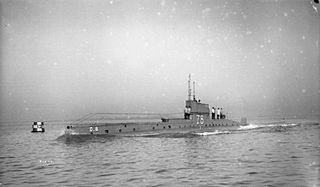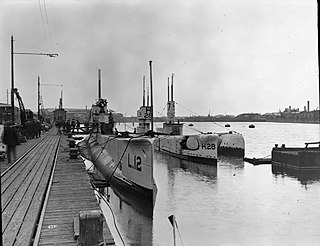HMS A12 was an A-class submarine built for the Royal Navy in the first decade of the 20th century. After surviving World War I, she was sold for scrap in 1920.
HMS L10 was a L-class submarine built for the Royal Navy during World War I. The boat was sunk in 1918 by German torpedo boats.

HMS D1 was one of eight D-class submarine built for the Royal Navy during the first decade of the 20th century.
HMS D5 was one of eight D-class submarines built for the Royal Navy during the first decade of the 20th century.
HMS D6 was one of eight D-class submarine built for the Royal Navy during the first decade of the 20th century.
HMS D7 was one of eight D-class submarines built for the Royal Navy during the first decade of the 20th century.

HMS D8 was one of eight D-class submarines built for the Royal Navy during the first decade of the 20th century.

HMS L1 was the lead boat of the L-class submarines built for the Royal Navy during World War I.

HMS C14 was one of 38 C-class submarines built for the Royal Navy in the first decade of the 20th century. The boat survived the First World War and was sold for scrap in 1921.
HMS C24 was one of 38 C-class submarines built for the Royal Navy in the first decade of the 20th century. The boat survived the First World War and was sold for scrap in 1921.

HMS Starfish was a first-batch S-class submarine built for the Royal Navy during the 1930s. Completed in 1933, she participated in the Second World War.
HMS C26 was one of 38 C-class submarines built for the Royal Navy in the first decade of the 20th century.

HMS C38 was one of 38 C-class submarines built for the Royal Navy in the first decade of the 20th century. The boat survived the First World War and was sold for scrap in 1919.

HMS C31 was one of 38 C-class submarines built for the Royal Navy in the first decade of the 20th century. She struck a mine in 1915 and sank with the loss of all hands.

HMS C34 was one of 38 C-class submarines built for the Royal Navy in the first decade of the 20th century. The boat was sunk by a German U-boat in 1917.
HMS C35 was one of 38 C-class submarines built for the Royal Navy in the first decade of the 20th century.

HMS L4 was a L-class submarine built for the Royal Navy during World War I. The boat survived the war and was sold for scrap in 1934.

HMS L6 was a L-class submarine built for the Royal Navy during World War I. The boat survived the war and was sold for scrap in 1935.

HMS L12 was a L-class submarine built for the Royal Navy during World War I. She was one of five boats in the class to be fitted as a minelayer. The boat survived the war and was sold for scrap in 1932.

HMS E24 was an E-class submarine of the Royal Navy built by Vickers, Barrow-in-Furness. She was launched on 9 December 1915 and was commissioned on 9 January 1916. E24 was a mine-laying submarine.













